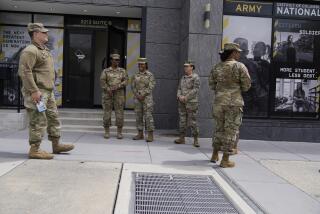McManus: A smaller, smarter military
President Obama has called a halt to the decade-long rise in defense spending that began after Sept. 11, and has proposed shrinking the Army and Marine Corps by about 14%.
Congressional Republicans (not to mention Mitt Romney) say that would be disastrous and that it could jeopardize American troops abroad.
But the military brass has stood behind Obama — literally. When the president announced his proposals, the Joint Chiefs of Staff lined up behind him in the Pentagon’s briefing room. There has been no audible dissent from the officer corps.
Last week I sat down with the chief of the service that’s taking the deepest hits, Gen. Raymond T. Odierno of the Army, to try to see the budget issues from a soldier’s perspective.
His take? He doesn’t relish shrinking the Army he has served in since 1972, but he accepts the need for a cap on spending growth.
“In all the learning I’ve ever done since I was a cadet at West Point, one of the things I found out is that the underpinning of any strong society is its economic capability and its political system,” he said.
“It’s essential that we do play [a part] in helping to get our budget right, to get our economy moving, to ensure that we reduce spending. And that’s what we’re doing.
“Would I have rather seen the budget cuts a bit less? Probably,” he said, suggesting that the Army might come back next year and ask for some spending to be restored.
The Army is slated to shrink by 80,000 troops, more than any other service. But Odierno points out that the Army also grew more than any other branch of the armed forces during the last decade. The proposed cuts would still leave the Army slightly larger than it was in 2001, with 490,000 active-duty troops.
“Some people say, well, the Army is the loser. In my mind I call it a rebalancing,” he said. “We’re now bringing our end strength back to where I think it needs to be. I feel comfortable with that.”
Ask this bull-necked artillery officer what new initiatives get him excited, and he doesn’t talk about new tanks or combat helicopters; in this budget, the Army isn’t getting them.
Instead, he talks about a new doctoral program to train officers in strategic planning, and he talks about educating more officers to become experts on Asia and the Middle East, about “cultural awareness” and “the human domain.”
One of the chief lessons he learned during his three combat tours in Iraq, Odierno said, is that the best-equipped army in the world can still lose a war if it doesn’t understand the people it’s fighting.
“There’s so much we don’t know,” he said.
When Odierno first arrived in Iraq during the U.S. invasion in 2003, he thought his mission was straightforward: to hunt down Saddam Hussein and the remnants of his regime. He led his 4th Infantry Division in massive sweeps of the Sunni provinces north of Baghdad and captured thousands of prisoners, including Hussein.
But that overwhelming-force, take-many-prisoners style of campaign didn’t lead to peace and democracy; instead, it helped stir up the insurgency against U.S. forces that exploded in 2004.
Odierno initially defended his muscular strategy, but he decided on reflection that he was wrong and that a more sophisticated form of counterinsurgency aimed at winning Iraqis’ trust and allegiance would have been a far better approach.
In 2006, Odierno and other military leaders changed course, forming an alliance with former insurgents in Anbar province and launching a surge in Baghdad. These initiatives helped bring the war under control.
The important thing, he concluded, was “understanding the environment, understanding the fabric that’s beneath a society” — knowledge he didn’t have when he arrived in Iraq in 2003.
If Army officers know more about the countries where they fight, in other words, they can do counterinsurgency better, and with fewer troops.
“The more we understand the human domain, the less people it will take,” he said.
Odierno’s emphasis on regional expertise also informs the approach he thinks the Pentagon should take in Asia, as the Obama administration shifts the focus of foreign policy toward the Pacific, where the Navy has historically ruled.
“Seven out of 10 of the world’s largest land armies are in Asia,” he points out. “In every country, the predominant service is the army.” If the United States wants to build relationships with Asian military establishments, the officers who will have the easiest time doing that will come from the U.S. Army, he says.
Up to now, history has remembered generals by the campaigns they fought. By that measure, Odierno has already made his mark through the successful surge in Iraq he helped orchestrate.
But ultimately, he may be remembered primarily for something less dramatic but more important: using the lessons of Iraq and Afghanistan to create a smaller but smarter force.
If he can pull that off, he’ll deserve the oil portrait he’s already guaranteed on the wall of the Pentagon’s Army corridor.
More to Read
Sign up for Essential California
The most important California stories and recommendations in your inbox every morning.
You may occasionally receive promotional content from the Los Angeles Times.











